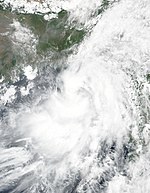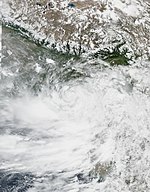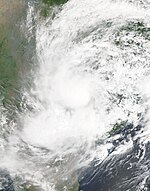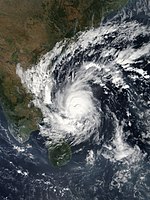Cyclone season in the North Indian 2018
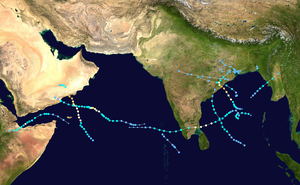
All the storms of the season
|
Formation of the
first storm |
March 13, 2018 |
Dissolution of the
last storm |
Season is still running |
| Strongest storm |
Mekunu - 960 hPa ( mbar ), 95 kn (175 km / h ) (3 minutes)
|
| Depression |
14th |
| Deep Depression |
9 |
| Cyclonic storms |
7th |
| Severe cyclonic storms |
5 |
| Very heavy cycl. Storms |
3 |
| Total number of victims |
329 total |
| Total damage |
$ 3.125 billion (2018) |
North Indian cyclone seasons
2016 , 2017 , 2018 , 2019 , 2020
|
The 2018 North Indian cyclone season includes events in the annual cycle of tropical cyclones . The cyclone season in the North Indian has no official limits as is usual in other basins, but runs all year round. The tropical cyclones usually form in this basin between April and December, with the months before and after the monsoon season , i.e. April / May and October / November, being the most active. A tropical cyclone in the Indian Ocean is known as a cyclone .
The Regional Specialized Meteorological Center (RSMC) responsible for the Indian Ocean between the Horn of Africa and the Malay Peninsula is the India Meteorological Department in New Delhi . This gives a name to those tropical cyclones that have at least the status of a cyclone. Low pressure areas (depending on the wind speed depressions or deep depressions ) are numbered consecutively, with the letter combination BOB indicating that the system was formed in the Bay of Bengal . The letters ARB stand for the Arabian Sea . Typically three to four cyclonic storms per year form in the Indian Ocean north of the equator.
The Joint Typhoon Warning Center (JTWC) in Honolulu issues separate warnings and forecasts for the US facilities in the Indian Ocean. The JTWC classifies according to the Saffir-Simpson hurricane wind scale , while the RSMC uses its own criteria for the classification, which are based, among other things, on the measurement of the continuous wind speed on the basis of a three-minute observation.
Season overview
Systems
Depression ARB 01
| Depression ( IMD )
|
|
|
| Duration
|
March 13th - March 15th
|
| intensity
|
25 kn (45 km / h ) (3 minutes) , 1006 hPa
|
On March 10, a low pressure area developed in the Indian Ocean not far from the equator . It appeared better defined on March 13th and organized itself into a depression in the extreme southeast of the Arabian Sea. The depression moved north-northwest and weakened early on March 15 over Lakshadweep to a pronounced low pressure area.
In the coastal town of Tuticorin on the southern tip of Tamil Nadu , 200 mm of rainfall was recorded on March 13; this value is the highest daily value recorded there so far. On Minicoy Island , 177 mm of precipitation was recorded. An unusual feature of the depression was that it formed very close to the equator , at only 1.7 degrees north latitude. Although the waters near the equator heat up faster because of the more intense solar radiation, the required effect due to the Coriolis force is less there. In addition, it was only the second time since observations began in 1891 that a tropical system had both formed and dissolved in the Arabian Sea in the months leading up to the monsoon season.
Cyclonic Storm Sagar
| Cyclonic Storm ( IMD )
|
| Tropical storm
|
|
|
| Duration
|
May 16 - May 20
|
| intensity
|
45 kn (85 km / h ) (3 minutes) , 994 hPa
|
On May 16, a low pressure area moved into the Gulf of Aden and deepened into a depression, whereupon it was named ARB 02 . The next day the system intensified into a cyclonic storm and was named Sagar . The system strengthened into a small, compact cyclone on May 18, forming an eye . Under the influence of a high pressure area over the Arabian Sea, the cyclone moved in a south-westerly direction and made landfall in Somalia , about 110 km west-northwest of Berbera , on May 19 between 1.30 and 2.30 p.m. IST .
Extremely Severe Cyclonic Storm Mekunu
| Extremely severe cyclonic storm ( IMD )
|
| Category 3 cyclone
|
|
|
| Duration
|
May 21st - May 27th
|
| intensity
|
95 kn (175 km / h ) (3 minutes) , 952 hPa
|
An active convection zone developed northwest of the Maldives on May 18 . In the course of the following two days the system organized itself better. On May 20, the IMD reported that a tropical low pressure area had formed and assigned the designation ARB 03 . The system slowly drifted northwestward into an environment favorable to tropical cyclogenesis , and it developed a good discharge . The JTWC issued a TCFA on May 21 after convective ribbons wrapped the Ground Circulation Center (LLCC). At around the same time the IMD announced that the system has intensified into a depression. Over the next 24 hours, the Depression continued drifting northwest over warm water and encountered low vertical wind shear. As a result, the system intensified and the JTWC began operating the system as a tropical storm. Accordingly, the IMD then classified the system as Deep Depression and during the day as Cyclonic Storm Mekunu . Multispectral satellite images showed that Mekunu had one eye trained on May 23, when the IMD upgraded the storm to a severe cyclonic storm . The cyclone benefited from the favorable environmental conditions and became more symmetrical, so that six hours later it had intensified into a very severe cyclonic storm . Under the influence of a subtropical high pressure ridge, the storm moved further north-westerly. On May 25, Mekunu peaked as an extremely severe cyclonic storm ; the JTWC estimated the maximum one-minute wind speeds to be 185 km / h, equivalent to a storm in Category 3 on the Saffir-Simpson Hurricane Wind Scale .
Mekunu caused heavy rain, flooding and torn down power lines on Socotra . According to initial reports, at least 40 people were missing after two ships capsized. Mekunu crossed the Omani coast not far from the city of Salala in great strength . Before the landfall, Salalah Airport reported wind gusts of 108 km / h, and parts of Salalah fell 194 mm of precipitation. As of May 31, at least 30 deaths were recorded in Oman and Yemen as a result of Mekunu, of which 20 were dead in Socotra, four in Yemen and six in Oman. The insured property damage in Oman was given at 73.9 million
OMR (about 190 million USD ).
Deep Depression BOB 01
| Deep Depression ( IMD )
|
| Tropical storm
|
|
|
| Duration
|
May 29th - May 30th
|
| intensity
|
30 kn (55 km / h ) (3 minutes) , 990 hPa
|
In the northeastern Gulf of Bengal, a low pressure area formed on May 28, which, due to favorable conditions, developed into a tropical low pressure area on May 29 and was named BOB 01 by the IMD . The system intensified during the day into a deep depression and hit the coast of Myanmar and Bangladesh at Kyaukpyu . Occasional local flooding occurred.
Myanmar's Bureau of Meteorology and Hydrology issued an emergency warning before the system arrived. Strong winds, accompanied by heavy rain, destroyed 500 houses in Shwe Pyi Tha in the Yangon region . Trees were knocked down, houses were covered and power was cut. Emergency shelters have been set up to accommodate people who have become homeless. Heavy rain and strong winds also damaged trees in Hmawbi, Dagon Myothit Nord, and elsewhere. The shipping between Angumaw and Sittway was interrupted by the authorities for three days.
Depression BOB 02
| Depression ( IMD )
|
|
|
| Duration
|
June 10th - June 10th
|
| intensity
|
25 kn (45 km / h ) (3 minutes) , 989 hPa
|
On June 9th, a low pressure area formed in the Bay of Bengal, which, thanks to favorable conditions, developed into a tropical depression on June 10th and was therefore classified as BOB 02 . Late that day, the system crossed the coast of Bangladesh in the Feni district before weakening into a well-developed depression.
The system brought heavy rain to the states of Odisha and West Bengal , and parts of Bangladesh fell extremely heavy as the monsoons advanced. Thunderstorm weather affected the ports in the northern and adjacent coastal waters in southeast Bangladesh. The seaports of Chattogram , Mongla and Payra hoisted the storm signal No. 3. In Patenga , 150 mm of rain fell within two days.
Depression BOB 03
| Depression ( IMD )
|
|
|
| Duration
|
July 21st - July 23rd
|
| intensity
|
25 kn (45 km / h ) (3 minutes) , 989 hPa
|
On July 20, a depression formed in the northwestern Gulf of Bengal not far from the coast of Odisha and West Bengal. This organized itself into a tropical depression on July 21st, which landed between Chandabali and Baleswar on the same day . The system triggered heavy monsoons that caused local flooding in parts of Odisha. In many areas around Bhubaneswar and Cuttack led to the formation of backwater , as both cities reported more than 200 mm of rainfall. In Burla in Odisha fell within 24 hours 627 mm of rainfall, and in Sambalpur fell in Odisha on July 22, 567 mm of rain within 24 hours, which is an absolute record for the city in July. The system maintained its intensity until it penetrated 400 km inland before weakening into a well-developed depression on July 23 in southeast Uttar Pradesh. The system also triggered rains over West Bengal. In Halisahar , 106 mm of rain fell within three days.
The system continued on its way west-northwest and reached the west of Uttar Pradesh and the capital New Delhi on July 26th with widespread rainfall. Meerut in Uttar Pradesh received 226 mm of rainfall on July 27, and New Delhi recorded 83 mm of rainfall between July 26 and 31. At least 69 people were killed in Uttar Pradesh as a result of the heavy rain and its effects. The level of the Yamuna in Delhi reached 205.5 meters above sea level on July 29th, 70 cm above the danger level, so that 1,500 people were evacuated.
Depression BOB 04
| Depression ( IMD )
|
|
|
| Duration
|
August 7 - August 8
|
| intensity
|
25 kn (45 km / h ) (3 minutes) , 992 hPa
|
Depression BOB 05
| Depression ( IMD )
|
|
|
| Duration
|
August 15 - August 17
|
| intensity
|
25 kn (45 km / h ) (3 minutes) , 994 hPa
|
Deep Depression BOB 06
| Deep Depression ( IMD )
|
|
|
| Duration
|
September 6th - September 7th
|
| intensity
|
30 kn (55 km / h ) (3 minutes) , 990 hPa
|
Cyclonic Storm Daye
| Cyclonic Storm ( IMD )
|
| Tropical storm
|
|
|
| Duration
|
September 19 - September 22
|
| intensity
|
35 kn (65 km / h ) (3 minutes) , 992 hPa
|
Very Severe Cyclonic Storm Luban
| Very Severe Cyclonic Storm ( IMD )
|
| Category 1 cyclone
|
|
|
| Duration
|
October 6th - October 15th
|
| intensity
|
75 kn (140 km / h ) (3 minutes) , 976 hPa
|
On October 6, a tropical depression formed in the Arabian Sea, which the IMD identified as ARB 04 . The next day, ARB 04 intensified into a deep depression that slowly moved westward. Early on October 8th, the system intensified into a cyclonic storm and was named Luban . The storm was now moving in a north-westerly direction.
On October 14th, Luban met the coast of Yemen. The country was in the midst of the Yemeni civil war and a cholera epidemic . 2203 families had to leave their homes. In total, at least 14 people were killed and 124 others injured by the effects of the storm in Yemen. The property damage in Yemen was assumed to be one billion US dollars.
Very Severe Cyclonic Storm Titli
| Very Severe Cyclonic Storm ( IMD )
|
| Category 2 cyclone
|
|
|
| Duration
|
October 8 - October 12
|
| intensity
|
80 kn (150 km / h ) (3 minutes) , 970 hPa
|
On October 6, a low pressure area formed in the Andaman Sea , which two days later in the eastern Bay of Bengal organized into a depression, to which the IMD assigned the designation BOB 08 . In the course of the day, the depression intensified into a deep depression. Then the storm intensified rapidly and turned into a Very Severe Cyclonic Storm on October 9, equivalent to Category 2 on the Saffir-Simpson Hurricane Wind Scale (SSHWS). Late arrived on 10 October Titli with peak intensity in Palasa in the district Srikakulam in Andhra Pradesh over the country.
The effects of Titli killed at least 77 people in Odisha - some more remained missing - and eight more were killed in Andhra Pradesh. The storm weakened to depression before reaching West Bengal, wreaking havoc in parts of South Bengal where it brought heavy rain and gusts of wind. The damage caused by the floods in Andhra Pradesh totaled ₹ 36.731 billion ($ 507 million) and ₹ 30 billion ($ 413 million) in Odisha.
Severe Cyclonic Storm Gaja
| Severe cyclonic storm ( IMD )
|
| Category 1 cyclone
|
|
|
| Duration
|
November 10th - November 20th
|
| intensity
|
60 kn (110 km / h ) (3 minutes) , 992 hPa
|
On November 5th, a low pressure area formed over the Gulf of Thailand , which crossed southern Thailand and the Malay Peninsula on November 8th and entered the Andaman Sea the next day. There the system was further organized and intensified on November 10th in the Bay of Bengal to a depression and received the designation BOB 09 from the IMD . A little later, the Joint Typhoon Warning Center issued a Tropical Cyclone Formation Alert. At 00:00 UTC on November 11th, the system intensified into a cyclonic storm and was named Gaja . After Gaja moved west-southwest for a few days, it hit the coast in southern India. The storm survived the overland passage into the Arabian Sea, but was broken up there a few days later due to unfavorable conditions.
The effects of the cyclone killed 63 people. Property damage was estimated at ₹ 54 billion ($ 775 million).
Cyclonic Storm Phethai
| Cyclonic Storm ( IMD )
|
| Tropical storm
|
|
|
| Duration
|
December 13 - Present
|
| intensity
|
45 kn (85 km / h ) (3 minutes) , 996 hPa
|
Storm names
Tropical cyclones in the Indian Ocean are named by the RSMC of the India Meteorological Department . The names are used only once each, so no devastating storm names are removed from the list of tropical cyclone names after the season ends . Storms that pull over from the western Pacific Ocean and maintain their circulation will continue to be listed under the name given there. The RSMC assigns a name if a system is classified at least as a Cyclonic Storm . The next nine names at the start of the season are:
|
|
|
- Phethai (BOB 10)
- Fani (unused)
- Vayu (unused)
|
See also
supporting documents
-
↑ Annual Frequency of Cyclonic Disturbances (Maximum Wind Speed of 17 Knots or More), Cyclones (34 Knots or More) and Severe Cyclones (48 Knots or More) Over the Bay of Bengal (BOB), Arabian Sea (AS) and Land Surface of India (PDF) India Meteorological Department. Retrieved October 30, 2015.
-
↑ RSMC - Tropical Cyclones New Delhi: Report on Cyclonic Disturbances over North Indian Ocean during 2009 . India Meteorological Department. Pp. 2-3. 2010. Archived from the original on April 5, 2010. Retrieved on May 24, 2011.
-
^ Rain to be double-edged sword for southern India into this weekend accuweather.com
-
↑ System in Arabian Sea weakens into low pressure area, to decay soon skymetweather.com
-
↑ BULLETIN NO. : 06 (BOB01 / 2018) rsmcnewdelhi.imd.gov.in (PDF)
-
↑ Abhishek Waghmare: Why the second depression in Arabian Sea in 125 years may be a damp squib (English) , Business Standard. March 14, 2018. Retrieved May 28, 2018.
-
^ Government of India. India Meteorological Department .: India Meteorological Department Press Release 1: Sub: Cyclonic Storm “Sagar” over Gulf of Aden (Time of issue: 1220 hours IST) ( English ) OCHA Reliefweb. May 17, 2018. Retrieved May 26, 2018.
-
^ Government of India. India Meteorological Department .: Tropical Storm "Sagar" Advisory No. Four Issued at 1400 UTC of 17th May 2018 based on 1200 UTC of 17th May 2018 ( English ) OCHA Reliefweb. 17 May 2018. Retrieved 26 May 2018.
-
↑ Tropical storm Sagar Develops 'eye' as it heads for Somalia (English) , Africa Times. May 18, 2018. Retrieved May 29, 2018.
-
↑ Bulletin No .: 22 (ARB02 / 2018) ( English ) Government of India. India Meteorological Department. May 19, 2018. Retrieved May 29, 2018.
-
↑ Significant Tropical Weather Advisory for the Indian Ocean: May 18, 2018, 1800Z ( English ) National Oceanic and Atmospheric Administration. Retrieved May 27, 2018.
-
↑ Informatory Message: 01 (ARB 03/2018) ( English ) India Meteorological Department. Retrieved May 27, 2018.
-
↑ Significant Tropical Weather Advisory For The Indian Ocean Reissued: 21 May 2018, 0400Z ( English ) National Oceanic and Atmospheric Administration. Retrieved May 25, 2018.
-
^ Tropical Cyclone Formation Alert ( English ) Joint Typhoon Warning Center. Retrieved May 25, 2018.
-
↑ Bulletin No. : 01 (ARB 03/2018) ( English ) India Meteorological Department. Retrieved May 25, 2018.
-
↑ Tropical Cyclone 02A (Two) Warning Nr 001 ( English ) Joint Typhoon Warning Center. Retrieved May 25, 2018.
-
↑ Deep Depression ARB 03: Bulletin 04 ( English ) India Meteorological Department. Retrieved May 25, 2018.
-
↑ Cyclonic Storm Mekunu: Bulletin 07 ( English ) India Meteorological Department. Retrieved May 25, 2018.
-
↑ Tropical Cyclone 02A (Mekunu) Warning Nr 006 ( English ) Joint Typhoon Warning Center. Retrieved May 25, 2018.
-
↑ Severe Cyclonic Storm Mekunu: Bulletin 12 ( English ) India Meteorological Department. Retrieved May 25, 2018.
-
↑ Tropical Cyclone 02A (Mekunu) Warning Nr 007 ( English ) Joint Typhoon Warning Center. Retrieved May 25, 2018.
-
↑ Very Severe Cyclonic Storm Mekunu: Bulletin 14 ( English ) India Meteorological Department. Retrieved May 25, 2018.
-
↑ Tropical Cyclone 02A (Mekunu) Warning Nr 014 ( English ) Joint Typhoon Warning Center. Retrieved May 25, 2018.
-
↑ In case you missed it: Deadly Cyclone Mekunu slams Socotra; Sinkhole opens on White House lawn ( English ) AccuWeather. Retrieved May 25, 2018.
-
↑ Tropical Cyclone Mekunu Making Historic Category 3 Landfall Near Salalah, Oman With Life-Threatening Flooding, Destructive Winds, Storm Surge ( English ) The Weather Channel. Retrieved May 25, 2018.
-
↑ Yemen: Cyclone Mekunu - Information bulletin No.2 ( English ) International Federation of Red Cross And Red Crescent Societies. Retrieved June 1, 2018.
-
↑ Jon Gambrell: Cyclone death toll in Oman, Yemen rises to at least 13 ( English ) The Associated Press. Retrieved May 28, 2018.
-
↑ Cyclone Mekunu: Insurance Claims reach up to OMR75 million (English) . In: Times of Oman , June 25, 2018. Retrieved September 7, 2018.
-
^ Currency Converter ( English ) Bank Muscat. Archived from the original on July 5, 2018. Info: The archive link was inserted automatically and has not yet been checked. Please check the original and archive link according to the instructions and then remove this notice. Retrieved July 5, 2018.
 @1@ 2Template: Webachiv / IABot / www.bankmuscat.com
@1@ 2Template: Webachiv / IABot / www.bankmuscat.com
-
↑ Red alert cyclone warning issued for Rakhine state, Myanmar (English) , Xinhua. May 30, 2018. Retrieved September 9, 2018.
-
↑ Myint Kay Thi: Forecasters warn of flash floods, landslides, storm surges (English) , Myanmar Times. May 30, 2018. Retrieved September 9, 2018.
-
↑ Cattogram city sees severe waterlogging with rains ( English ) United News of Bangladesh. June 11, 2018. Retrieved September 10, 2018.
-
↑ Arun Nair: 58 Killed As Rain Wreaks Havoc In Uttar Pradesh . NDTV. July 28, 2018. Retrieved December 15, 2018.
-
^ UP: Sixty nine killed in rain-related incidents in four days ( English ) Times of India.
-
↑ Over 1000 families evacuated as Yamuna continues flowing above danger mark (English) , The Hindu. July 28, 2018. Retrieved December 15, 2018.
-
↑ Global Emergency Overview Weekly Picks, October 16, 2018 ( English ) In: Assessment Capacities Project . ReliefWeb. October 16, 2018. Accessed in 2018-1216.
-
↑ Yemen: Cyclone Luban Flash Update # 3 (21 October 2018) ( English ) In: United Nations Office for the Coordination of Humanitarian Affairs . ReliefWeb. October 21, 2018. Retrieved December 16, 2018.
-
↑ Yemen says 14 killed in Cyclone Luban (English) . In: Associated Press , Associated Press, October 28, 2018. Retrieved December 16, 2018.
-
↑ Govt. Report: Luban Storm cost US $ one billion (English) , Debriefer. November 2, 2018. Retrieved December 16, 2018.
-
↑ Titli toll 77; missing cases under lens (English) , Orissa Post. October 24, 2018. Retrieved December 16, 2018.
-
↑ Stela Dey: Cyclone Titli Live Highlights: 8 Dead In Andhra Pradesh, Bus Services Suspended (English) , NDTV. October 11, 2018. Retrieved December 16, 2018.
-
↑ Vikash Sharma: Cyclone Titli death toll rises to 62 in Odisha ( English ) Odisha TV. October 21, 2018. Retrieved December 16, 2018.
-
↑ Chandrababu Naidu urges fast release of aid to rehabilitate Titli victims (English) , ANI. October 26, 2018. Retrieved December 16, 2018.
-
^ V Kamalakara Rao: Support dries up for Srikakulam, Odisha after charity blitz in Kerala (English) , Times of India. October 24, 2018. Retrieved December 16, 2018.
-
↑ Dharani Thangavelu: Tamil Nadu seeks Rs 15,000 crore from Center to rebuild after cyclone Gaja (English) , Livemint. November 22, 2018. Retrieved December 16, 2018.
-
↑ Global Catastrophe Recap November 2018 ( English , PDF, 745 kB) December 6, 2018. Accessed December 16, 2018.
Web links








